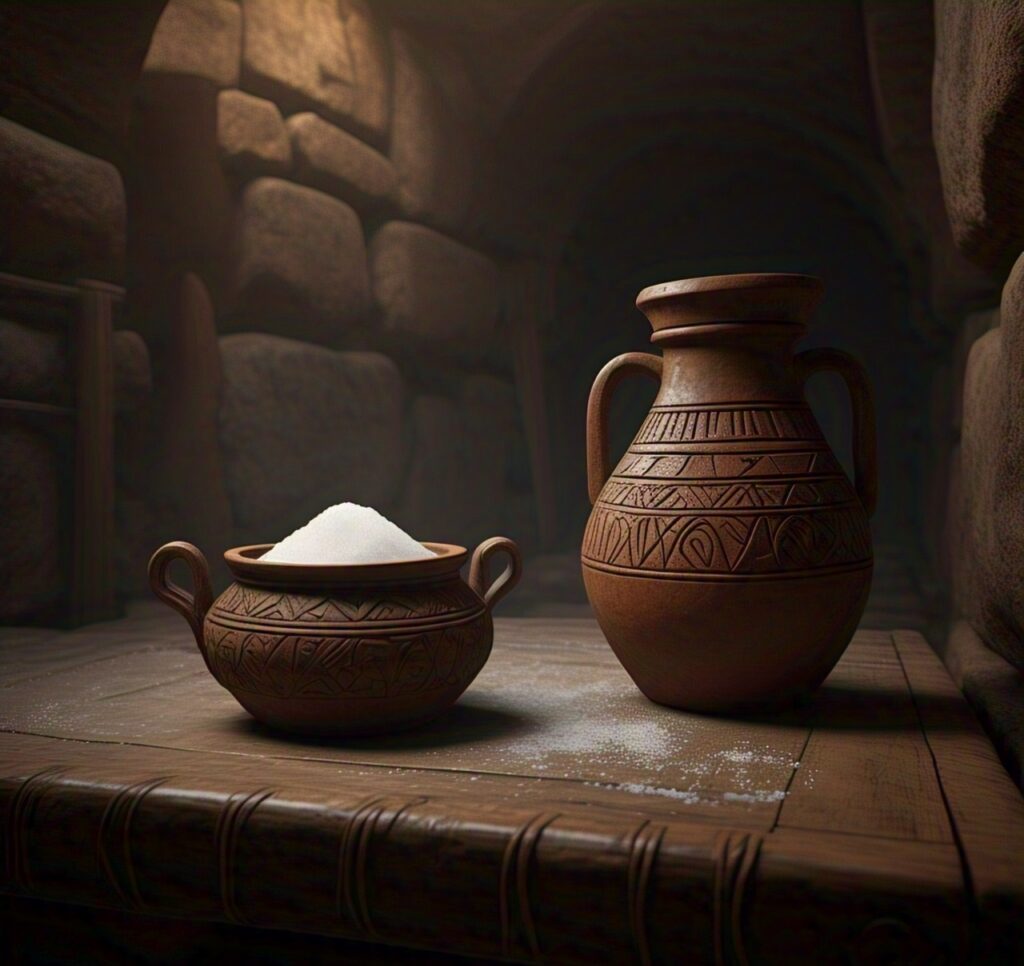
In this article, we will look at the story of two vessels in the Bible used by God as examples of how our lives should be use. Vessels always symbolized human lives, being mold and shaped by the hands of God. There are two vessels in our story, one filled with salt and the other with oil:
Two powerful passages from 2 Kings reveal deep truths about God’s transformative power and the role we play in His divine purpose. The stories of the healed waters at Jericho and the multiplication of oil for a widow both highlight how God uses vessels—whether physical or spiritual—to bring life, healing, and abundance. Let’s explore these two stories and see how they offer lessons for our own lives as vessels in God’s hands.
1. The Healed Waters at Jericho (2 Kings 2:19-22)
2 Kings2:19-22:
19And the men of the city said unto Elisha, Behold, I pray thee, the situation of this city is pleasant, as my lord seeth: but the water is naught, and the ground barren.
20And he said, Bring me a new cruse, and put salt therein. And they brought it to him.
21And he went forth unto the spring of the waters, and cast the salt in there, and said, Thus saith the LORD, I have healed these waters; there shall not be from thence any more death or barren land.
22So the waters were healed unto this day, according to the saying of Elisha which he spake.
In 2 Kings 2:19-22, the men of Jericho came to the prophet Elisha with a problem: their water source was bad, leading to unfruitfulness and barrenness in the land. Elisha’s response reveals a profound spiritual lesson about the need for transformation at the source. He asked for a new bowl, filled it with salt, and threw it into the water source. Miraculously, the water was healed, and life and fertility were restored.
Water as the Source of Life
Water in Scripture often symbolizes life and refreshment. In this story, the bad water represents a source of spiritual corruption or contamination, leading to barrenness, unfruitful life. Just as clean water is essential for physical life, so spiritual purity is essential for a fruitful, flourishing life in Christ. When our spiritual “water” is tainted—whether by sin, wrong beliefs, or negative influences—our lives become barren and unfruitful.
Salt: The Word of God
Elisha’s choice of using salt to cure the water is highly significant. In biblical times, salt was a preservative, used to prevent decay and corruption. In Matthew 5:13-16, the Lord Jesus calls us as the “salt of the earth,” implying that we are to preserve goodness and truth in a world prone to decay. Salt represents the Word of God, which preserves us from the corruption of sin. When the Word of God was put to the “vessel” (our lives), it brings healing and restoration when use.
A New Vessel: The Born-Again Life
The story also mentions that Elisha asked for a “new vessel” to carry the salt. This new vessel represents the necessity of being born again. Just as the Lord Jesus told Nicodemus in John 3:3, “You must be born again,” we cannot contain or carry the transformative power of God’s Word unless we ourselves are made new. When we become new creations in Christ, we are fit vessels to hold and share the truth that heals and restores the brokenness around us.
Going to the Source of the Problem
Elisha didn’t just sprinkle the salt anywhere; he went to the source of the problem and sprinkle it there. This teaches us an important lesson: we must allow God to heal us at the very root of our issues. Often, we attempt to manage the symptoms of our problems without addressing the deeper spiritual roots. However, God wants to bring healing to the very source of our pain, sin, and brokenness. When we allow Him to touch the deepest places in our hearts, we experience true healing and fruitfulness.
2. The Widow’s Oil (2 Kings 4:1-7)
2 Kings 4:1-7:
1Now there cried a certain woman of the wives of the sons of the prophets unto Elisha, saying, Thy servant my husband is dead; and thou knowest that thy servant did fear the LORD: and the creditor is come to take unto him my two sons to be bondmen.
2And Elisha said unto her, What shall I do for thee? tell me, what hast thou in the house? And she said, Thine handmaid hath not any thing in the house, save a pot of oil.
3Then he said, Go, borrow thee vessels abroad of all thy neighbours, even empty vessels; borrow not a few.
4And when thou art come in, thou shalt shut the door upon thee and upon thy sons, and shalt pour out into all those vessels, and thou shalt set aside that which is full.
5So she went from him, and shut the door upon her and upon her sons, who brought the vessels to her; and she poured out.
6And it came to pass, when the vessels were full, that she said unto her son, Bring me yet a vessel. And he said unto her, There is not a vessel more. And the oil stayed.
7Then she came and told the man of God. And he said, Go, sell the oil, and pay thy debt, and live thou and thy children of the rest.
The second story, found in 2 Kings 4:1-7, tells of a widow who was in desperate need. Her husband had died, and creditors were coming to take her two sons as slaves to repay the debt. When she sought help from Elisha, he asked her what she had in her house. She replied, “Nothing but a jar of oil.” Elisha instructed her to gather as many empty vessels as she could, and then begin pouring the oil into them. Miraculously, the oil continued to flow until every vessel was full.
Oil: The Holy Spirit
In the Scripture, oil often symbolizes the Holy Spirit. Just as the widow’s oil filled every available vessel, the Holy Spirit fills every life that is yielded to Him. The oil didn’t run out until the vessels ran out, illustrating that God’s supply of the Holy Spirit is limitless. The only limit to how much of the Spirit we can receive is our own capacity and willingness to be filled.
The Vessel’s Color, Shape, or Size Doesn’t Matter
Elisha didn’t specify that the vessels had to be of a particular size, shape, or color. This teaches us that God doesn’t look at our outward appearance or qualifications when He fills us with His Spirit. What matters is that we are available and willing to be used. As 2 Corinthians 4:7 reminds us, we have “this treasure in jars of clay, to show that the surpassing power belongs to God and not to us.” The value is in what’s inside the vessel, not the vessel itself.
The Vessel Must Be Empty
One key to being filled with the Holy Spirit is emptiness. The vessels that the widow gathered had to be empty in order to be filled with oil. In the same way, we must come to God empty—empty of pride, self-reliance, and worldly attachments—so that He can fill us with His Spirit. God can only fill what is open and available to Him. If we are too full of ourselves or the things of this world, we leave no room for the Holy Spirit to work in and through us.
The Vessels Must Keep Coming
The oil stopped flowing only when there were no more vessels to fill. This teaches us an important lesson about continually coming to God to be filled. Our need for the Holy Spirit is ongoing; it’s not a one-time event. Just as the widow needed to keep bringing vessels, we need to keep coming to God in humility and openness, allowing Him to fill us again and again.
Lessons from the Two Vessels
These two stories of vessels—one filled with salt and the other with oil—carry profound spiritual lessons:
1. God’s Power to Heal and Restore: Just as Elisha healed the waters at Jericho, God can heal the broken and barren areas of our lives. He applies the salt of His Word to the source of our problems, bringing life and fruitfulness where there was once death and barrenness.
2. The Importance of Being a New Vessel: To carry the salt of the Word and the oil of the Spirit, we must be made new. Only a born-again life can contain the transformative power of God.
3. The Power of the Holy Spirit: The oil represents the Holy Spirit, and God desires to fill us with His Spirit in abundance. But we must come to Him empty, willing to be filled, and continually seeking His presence.
4. God Uses What We Have: In both stories, God worked with what was already available—the water and the widow’s oil. Often, we feel inadequate or ill-equipped, but God can use whatever we have, as long as we offer it to Him in faith.
5. The Need to Keep Coming to God: Just as the widow had to keep bringing vessels, we must keep coming to God, seeking to be filled with His Spirit over and over. The flow of God’s power doesn’t run out, but we must continually seek Him to receive it.
Conclusion
In both stories, we see the overwhelming grace and provision of God. Whether it’s healing bitter waters or multiplying oil to provide for a desperate widow, God’s power is limitless, and His desire is to bless His people. But we must position ourselves as willing vessels—empty, new, and ready to be filled. God will always meet us at the source of our need, and as we continually seek Him, He will fill us with His life-giving Spirit, enabling us to pour out His grace and power to others.
![]()




More Stories
THE PREHISTORIC EARTH
HE SAT WITH ME WHILE I WAS BROKEN
YOU WERE CHOSEN IN THE DARK